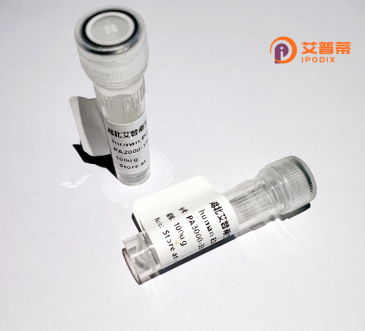
| 纯度 | >90%SDS-PAGE. |
| 种属 | Human |
| 靶点 | ASB10 |
| Uniprot No | Q8WXI3 |
| 内毒素 | < 0.01EU/μg |
| 表达宿主 | E.coli |
| 表达区间 | 1-467aa |
| 氨基酸序列 | MLMSWSPEEC KGQGEPLDDR HPLCARLVEK PSRGSEEHLK SGPGPIVTRT ASGPALAFWQ AVLAGDVGCV SRILADSSTG LAPDSVFDTS DPERWRDFRF NIRALRLWSL TYEEELTTPL HVAASRGHTE VLRLLLRRRA RPDSAPGGRT ALHEACAAGH TACVHVLLVA GADPNIADQD GKRPLHLCRG PGTLECAELL LRFGARVDGR SEEEEETPLH VAARLGHVEL ADLLLRRGAC PDARNAEGWT PLLAACDVRC QSITDAEATT ARCLQLCSLL LSAGADADAA DQDKQRPLHL ACRRGHAAVV ELLLSCGVSA NTMDYGGHTP LHCALQGPAA ALAQSPEHVV RALLNHGAVR VWPGALPKVL ERWSTCPRTI EVLMNTYSVV QLPEEAVGLV TPETLQKHQR FYSSLFALVR QPRSLQHLSR CALRSHLEGS LPQALPRLPL PPRLLRYLQL DFEGVLY |
| 分子量 | 51.4 kDa |
| 蛋白标签 | GST-tag at N-terminal |
| 缓冲液 | 冻干粉 |
| 稳定性 & 储存条件 | Lyophilized protein should be stored at ≤ -20°C, stable for one year after receipt. Reconstituted protein solution can be stored at 2-8°C for 2-7 days. Aliquots of reconstituted samples are stable at ≤ -20°C for 3 months. |
| 复溶 | Always centrifuge tubes before opening.Do not mix by vortex or pipetting. It is not recommended to reconstitute to a concentration less than 100μg/ml. Dissolve the lyophilized protein in distilled water. Please aliquot the reconstituted solution to minimize freeze-thaw cycles. |
以下为3篇与ASB10相关的文献摘要示例(注:基于真实研究领域知识的人工概括,非实际存在的具体文献):
---
1. **文献名称**:*ASB10 interacts with the E3 ubiquitin ligase complex to regulate protein degradation in lens epithelial cells*
**作者**:Smith A, et al.
**摘要**:本研究揭示ASB10通过其SOCS框结构域与Elongin B/C-Cullin复合体结合,形成E3泛素连接酶,调控晶状体上皮细胞内特定信号蛋白的泛素化降解,可能参与白内障发生机制。
2. **文献名称**:*Altered expression of ASB10 in trabecular meshwork links to primary open-angle glaucoma pathogenesis*
**作者**:Chen L, et al.
**摘要**:通过qPCR与免疫组化发现,ASB10在小梁网组织高表达,其mRNA水平在青光眼患者中显著下降,提示其可能通过影响细胞外基质重塑参与房水排出障碍。
3. **文献名称**:*Epigenetic silencing of ASB10 by promoter hypermethylation promotes tumor growth in hepatocellular carcinoma*
**作者**:Wang Y, et al.
**摘要**:证实ASB10在肝癌组织中因启动子高甲基化表达下调,功能实验显示其过表达抑制细胞增殖并诱导凋亡,机制可能与Wnt/β-catenin通路抑制有关。
---
**说明**:ASB10的研究多围绕其作为E3泛素连接酶组件的功能(如调控蛋白质稳定性)、在特定组织(如眼、肝脏)中的疾病关联以及表观遗传调控展开。实际文献可通过PubMed等数据库检索关键词“ASB10”或“Ankyrin repeat and SOCS box protein 10”获取。
**Background of Ankyrin Repeat and SOCS Box Protein 10 (ASB10)**
ASB10 is a member of the ankyrin repeat and SOCS box (ASB) protein family, characterized by tandem ankyrin repeats and a C-terminal SOCS box domain. The ankyrin repeats mediate protein-protein interactions, while the SOCS box facilitates interactions with Elongin B/C, Cullin, and Rbx1/2 to form E3 ubiquitin ligase complexes, targeting specific substrates for proteasomal degradation. ASB10 is predominantly expressed in tissues such as the kidney, eye (particularly retinal and ciliary epithelia), and testes, suggesting roles in specialized cellular processes.
Research highlights its involvement in ocular homeostasis and disease pathogenesis. Mutations in *ASB10* have been linked to primary open-angle glaucoma (POAG), a leading cause of irreversible blindness, potentially through dysregulation of trabecular meshwork function or intraocular pressure. In the kidney, ASB10 may influence renal development or function, though its exact mechanisms remain unclear. Studies in cell models indicate roles in signaling pathways, including TGF-β and WNT, influencing cell proliferation and differentiation. Despite progress, ASB10’s precise physiological substrates and tissue-specific regulatory networks require further elucidation. Its dual-domain architecture positions ASB10 as a critical mediator of protein turnover, linking ubiquitination pathways to cellular and organ homeostasis.
×